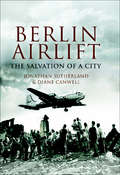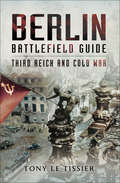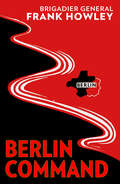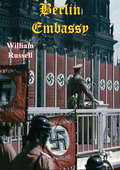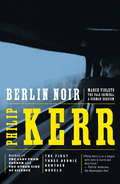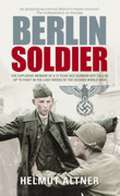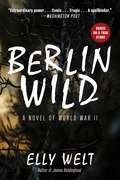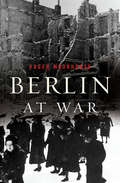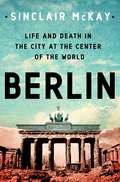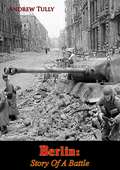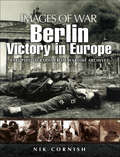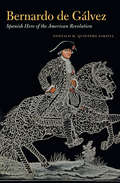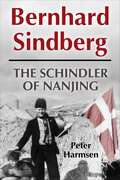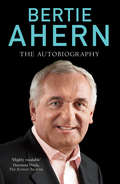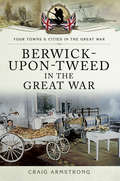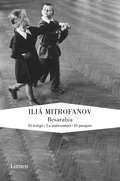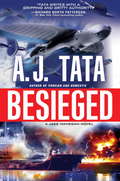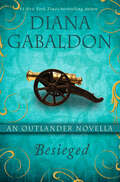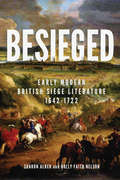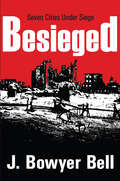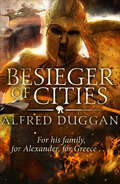- Table View
- List View
Berlin Airlift: The Salvation Of A City
by Jon SutherlandIn June 1948, Joseph Stalin halted all road and rail traffic in to and out of the Allied sector of Berlin and cut off all electricity to the city. The only route into Berlin was by means of three twenty-mile-wide air corridors across the Soviet zone of Germany. Thus the wartime allies of Britain, France and the USA realized that the only option open to them was to supply the beleaguered West Berlin by air transport and so started one of the most dramatic events of the twentieth century. The airlift started in June, 1948. At the beginning there were three loading airfields: Rhein Main and Wiesbaden in the American zone, and Weinstorf in the British zone. By September of 1948 the airlift was transporting a massive tonnage of supplies into Berlin, including coal, food, medical supplies and all the other necessities of life. A mixed fleet of aircraft plodded their endless path to and from the city. Both Ex-planes and pilots were dragged out of retirement. In September 1948 the Russian military threatened to force down western aircraft if they flew outside the 20-mile wide corridors but by March 1949 a total of 45,683 tons of supplies per week were being flown into Berlin. In April Russia finally announced her intention to end the blockade.
Berlin Battlefield Guide: Third Reich & Cold War
by Tony Le TissierA comprehensive look at World War II battle sites in the German capital. On April 16, 1945, the Red Army unleashed a colossal offensive against Berlin with the aim of destroying Hitler&’s armies in the East and capturing the German capital before the Western Allies. Over two million soldiers confronted each other in the last act in the war against Nazi Germany. In the course of the next three weeks, relentless Soviet assaults crashed against a desperate, sometimes suicidal defense, and the historic city was turned into a vast battleground. This was the climax of an awful conflict. It represented the death struggle of Hitler&’s Third Reich and the supreme achievement of Stalin&’s forces, and the story of the battle has fascinated students of warfare ever since. Yet this epic contest can only be understood by visiting the sites of the battle on the ground, on the outskirts of the city, in the suburbs, in the city center where the final dramatic combat took place. And this is the aim of Tony Le Tissier&’s definitive guide to the Battle of Berlin.
Berlin Command
by Frank L. HowleyBerlin Command, first published in 1950, is Brig. General Frank Howley's account of his four-year tenure in post-World War II Berlin with the U.S. Military Government. Filled with stories of Soviet complicity in undermining Allied efforts to rebuild the city, the book is throughout a testament to the ideals of freedom and democracy and the American determination to remain in Berlin, even though surrounded by a hostile opponent willing to lie, cheat, kidnap, rape, and steal to achieve its ends. Howley oversaw Allied efforts to counter the Soviets, and was instrumental in organizing massive airlifts of food, heating fuel, and other supplies that meant survival for the hungry, cold Berliners. General Howley was an unsung hero of the early Cold War period, and Berlin Command is a fascinating account of this historic period when Europe's fate was still being decided.
Berlin Diary: The Journal Of A Foreign Correspondent, 1934-1941
by William L. ShirerThe author of the international bestseller The Rise and Fall of the Third Reich offers a personal account of life in Nazi Germany at the start of WWII. By the late 1930s, Adolf Hitler, Führer of the Nazi Party, had consolidated power in Germany and was leading the world into war. A young foreign correspondent was on hand to bear witness. More than two decades prior to the publication of his acclaimed history, The Rise and Fall of the Third Reich, William L. Shirer was a journalist stationed in Berlin. During his years in the Nazi capital, he kept a daily personal diary, scrupulously recording everything he heard and saw before being forced to flee the country in 1940. Berlin Diary is Shirer&’s first-hand account of the momentous events that shook the world in the mid-twentieth century, from the annexation of Austria and Czechoslovakia to the fall of Poland and France. A remarkable personal memoir of an extraordinary time, it chronicles the author&’s thoughts and experiences while living in the shadow of the Nazi beast. Shirer recalls the surreal spectacles of the Nuremberg rallies, the terror of the late-night bombing raids, and his encounters with members of the German high command while he was risking his life to report to the world on the atrocities of a genocidal regime. At once powerful, engrossing, and edifying, William L. Shirer&’s Berlin Diary is an essential historical record that illuminates one of the darkest periods in human civilization.
Berlin Embassy
by William Russell“First published in 1941 to considerable acclaim, Berlin Embassy is the classic account of the last days of peace in Europe, and has been out-of-print for almost fifty years. William Russell was a young American diplomat working at the US Embassy, in Hermann Goering Strasse, during the grim days of 1939. He had studied in Germany, prior to becoming part of America’s diplomatic mission, which placed him in a position to gain unheard of access to remote areas—both physically and ideologically—of German society during one of the most momentous times in world history. Russell does not miss any opportunity to capitalize on this unique position as he gives a totally absorbing account of both the horror and farce which so often defines such epic times. This quite remarkable account is sure to find a whole new readership.”-Print ed.“Vitally significant and impressive.”—William L. Shirer.
Berlin Finale (Penguin Modern Classics)
by Heinz ReinOne of the first bestsellers in Germany after the Second World War, Berlin Finale is a breathtaking novel of resistance set against the downfall of the Third ReichApril 1945, the last days of the Nazi regime. While bombs are falling on Berlin, the Gestapo still search for traitors, resistance fighters and deserters. People mistrust each other more than ever. In the midst of chaos, a disparate group - a disillusioned young soldier; a trade unionist and saboteur; a doctor helping refugees - continues to fight back. And in Oskar Klose's pub, the resistance plan their next move, hunted at every step by the SS. Published in the immediate aftermath of the Second World War, Berlin Finale is an unforgettable portrait of life in a city devastated by war.Translated by Shaun Whiteside
Berlin Noir: March Violets; The Pale Criminal; A German Requiem (Crime, Penguin)
by Philip KerrIn BERLIN NOIR, Philip Kerr's first three Bernie Gunther novels - MARCH VIOLETS, THE PALE CRIMINAL, A GERMAN REQUIEM -- are compiled in one volume, the perfect introduction to the "best crime series around today" (The Daily Beast).Ex-policeman Bernie Gunther thought he'd seen everything on the streets of 1930s Berlin. But then he went freelance, and each case he tackled sucked him further into the grisly excesses of Nazi subculture. And even after the war, amidst the decayed, imperial splendour of Vienna, Bernie uncovered a legacy that made the wartime atrocities look lily-white in comparison...From the Trade Paperback edition.
Berlin Soldier: The Explosive Memoir of a 12 Year-old German Boy Called Up to Fight in the Last Weeks of the Second World War
by Helmut Altner Tony TissierThis book is an explosive memoir of a 17 year old German boy called up to fight in the last weeks of the Second World War. This is a teenager's vivid account of his experiences as a conscript during the final desperate weeks of the Third Reich, during which he experienced training immediately behind the front line east of Berlin, was caught up in the massive Soviet assault on Berlin from the Oder, retreated successfully and then took part in the fight for the western suburb of Spandau, where he became one of the only two survivors of his company of seventeen year-olds.
Berlin Wild: A Novel of World War II
by Elly Welt"One of the best I've ever read." —Chicago Tribune "Extraordinary power . . . Comic . . .Tragic . . . A spellbinder." —The Washington Post "Earns four stars . . . A wonderful book . . . Read it, by all means, and give it to a friend." —San Francisco Chronicle "This novel hooks the reader on the first page and does not let go." —USA Today "Pain and laughter . . . The author had the genius to allow comedy to dominate this powerful story of struggle." —The Washington Book Review Dr. Josef Bernhardt, an anesthesiologist on the faculty of medicine at the University of Iowa, has tried his whole life to shut out the events of his youth in Berlin during the 1940s, but one incident in his operating room pulls him right back… It&’s 1943, and sixteen-year-old Josef has been invited to leave his family and take up residence at the Wilhelm Institute of Berlin. Half-Jewish, he is unable to attend his high school due to Nazi laws, but as a mathematical genius, he has gained access to an opportunity that will assumedly spare and support him and eight other &“special cases.&” Though Josef is unable to forget about the war and the unknown fate of his family for the two years the Institute offers him sanity and safety, he and the others manage to discover friendship, love, and generosity within and between each other. They work side by side, under the direction of Professor Avilov (The Chief), on genetic experiments and nuclear research—quietly attempting to sabotage the war that is funding their work. Each day for two years, Josef fears that the dreamlike opportunity he has been dropped into might shatter, and that the nightmare of the genocide and war outside will infiltrate his safe haven.Berlin Wild is based on an astonishingly true story of survival.
Berlin at War: Life And Death In Hitler's Capital, 1939-1945
by Roger MoorhouseBerlin was the city at the very center of World War Two. It was the launching pad for Hitler’s empire, the embodiment of his vision of a "world metropolis. ” Berlin was also the place where Hitler’s Reich would ultimately fall. Berlin suffered more air raids than any other German city and endured the full force of a Soviet siege. In Berlin at War, historian Roger Moorhouse uses diaries, memoirs, and interviews to provide a searing first-hand account of life and death in the Nazi capital--the privations, the hopes and fears, and the nonconformist tradition that saw some Berliners provide underground succour to the city’s remaining Jews. Combining comprehensive research with gripping narrative, Berlin at War is the incredible story of the city--and people--that saw the whole of World War Two.
Berlin: Life and Death in the City at the Center of the World
by Sinclair McKaySinclair McKay's portrait of Berlin from 1919 forward explores the city's broad human history, from the end of the Great War to the Blockade, rise of the Wall, and beyond.Sinclair McKay's Berlin begins by taking readers back to 1919 when the city emerged from the shadows of the Great War to become an extraordinary by-word for modernity—in art, cinema, architecture, industry, science, and politics. He traces the city’s history through the rise of Hitler and the Battle for Berlin which ended in the final conquest of the city in 1945. It was a key moment in modern world history, but beyond the global repercussions lay thousands of individual stories of agony. From the countless women who endured nightmare ordeals at the hands of the Soviet soldiers to the teenage boys fitted with steel helmets too big for their heads and guns too big for their hands, McKay thrusts readers into the human cataclysm that tore down the modernity of the streets and reduced what was once the most sophisticated city on earth to ruins.Amid the destruction, a collective instinct was also at work—a determination to restore not just the rhythms of urban life, but also its fierce creativity. In Berlin today, there is a growing and urgent recognition that the testimonies of the ordinary citizens from 1919 forward should be given more prominence. That the housewives, office clerks, factory workers, and exuberant teenagers who witnessed these years of terrifying—and for some, initially exhilarating—transformation should be heard. Today, the exciting, youthful Berlin we see is patterned with echoes that lean back into that terrible vortex. In this new history of Berlin, Sinclair McKay erases the lines between the generations of Berliners, making their voices heard again to create a compelling, living portrait of life in this city that lay at the center of the world.
Berlin: Story Of A Battle
by Andrew TullyAt the end of World War II, Andrew Tully was one of three Americans allowed to enter Berlin as a guest of a Russian artillery battalion commander. He spent the next seventeen years gathering eyewitness accounts, collecting war diaries and letters, and reading over one hundred books in order to write this gripping and comprehensive account about the fall of Berlin.Originally published in the U.S. in 1963, Berlin: Story of a Battle has also been translated into French, Dutch, Italian and Japanese.
Berlin: Victory in Europe (Images of War)
by Nik CornishIn April and May 1945 the city of Berlin was the site of the final destructive act of the Second World War in Europe. The German capital became a battleground. After three weeks of ruthless fighting against a desperate, sometimes suicidal, defense, the Red Army took the city and crushed the last remaining German armies in the East. This momentous battle and the elaborate preparations for it were recorded in graphic detail by photographers whose images have come down to us today. These images, which give us an unforgettable glimpse into the grim reality of mid-twentieth-century warfare, are the raw material of Nik Cornishs evocative book.Using a rich selection of rare photographs from the Russian archives as well as images from German sources, most of which have not been published before, he traces the course of the entire campaign. The battles fought in East Prussia, eastern Germany and Hungary in particular the assault on Budapest are covered. But the body of his book is devoted to the battle for Berlin itself—the monstrous onslaught launched by Zhukovs armies on the Seelow Heights, the bitter street fighting through the suburbs, then the ultimate confrontation, the merciless room-by-room struggle for the center of the city and the Reichstag.
Bernardo de Gálvez: Spanish Hero of the American Revolution
by Gonzalo M. Quintero SaraviaAlthough Spain was never a formal ally of the United States during the American Revolution, its entry into the war definitively tipped the balance against Britain. Led by Bernardo de Galvez, supreme commander of the Spanish forces in North America, their military campaigns against British settlements on the Mississippi River—and later against Mobile and Pensacola—were crucial in preventing Britain from concentrating all its North American military and naval forces on the fight against George Washington's Continental army. In this first comprehensive biography of Galvez (1746@–86), Gonzalo M. Quintero Saravia assesses the commander's considerable historical impact and expands our understanding of Spain's contribution to the war.A man of both empire and the Enlightenment, as viceroy of New Spain (1785@–86), Galvez was also pivotal in the design and implementation of Spanish colonial reforms, which included the reorganization of Spain's Northern Frontier that brought peace to the region for the duration of the Spanish presence in North America. Extensively researched through Spanish, Mexican, and U.S. archives, Quintero Saravia's portrait of Galvez reveals him as central to the histories of the Revolution and late eighteenth-century America and offers a reinterpretation of the international factors involved in the American War for Independence.
Bernhard Sindberg: The Schindler of Nanjing
by Peter Harmsen"...shows that sometimes the most unlikely of people become the most heroic." — Asian Review of Books In December 1937, the Chinese capital, Nanjing, falls and the Japanese army unleash an orgy of torture, murder, and rape. Over the course of six weeks, hundreds of thousands of civilians and prisoners of war are killed. At the very onset of the atrocities, the Danish supervisor at a cement plant just outside the city, 26-year-old Bernhard Arp Sindberg, opens the factory gates and welcomes in 10,000 Chinese civilians to safety, beyond the reach of the blood-thirsty Japanese. He becomes an Asian equivalent of Oskar Schindler, the savior of Jews in the European Holocaust. This biography follows Sindberg from his childhood in the old Viking city of Aarhus and on his first adventures as a sailor and a Foreign Legionnaire to the dramatic 104 days as a rescuer of thousands of helpless men, women, and children in the darkest hour of the Sino-Japanese War. It describes how after his remarkable achievement, he receded back into obscurity, spending decades more at sea and becoming a naturalized American citizen, before dying of old age in Los Angeles in 1983, completely unrecognized. In this respect, too, there is an obvious parallel with Schindler, who only attained posthumous fame. The book sets the record straight by providing the first complete account of Sindberg’s life in English, based on archival sources hitherto unutilized by any historian as well as interviews with surviving relatives. What emerges is the surprising tale of a person who was average in every respect but rose to the occasion when faced with unimaginable brutality, discovering an inner strength and courage that transformed him into one of the great humanitarian figures of the 20th century and an inspiration for our modern age, demonstrating that the determined actions of one person—any person—can make a huge difference.
Bertie Ahern Autobiography: The Autobiography
by Bertie AhernBertie Ahern, three times Irish Taoiseach, is often described as an enigma. The Old IRA man's son who delivered peace in Northern Ireland. A working class boy responsible for the Celtic Tiger. The man of faith who ushered in progressive, cosmopolitan secular Ireland. An ardent nationalist admired by European leaders. 'I know 25 per cent of Bertie Ahern', said his finance minister, Charlie McCreevy, 'and that's 24 per cent more than anyone else.'Now in this frank and revealing autobiography, Ahern gives his own account of a remarkable political life and the personal story that accompanies it. He shows the cost to his family of a life played out in the public eye and, for the first time, discloses what really happened in his final weeks in power.Here for the first time is the truth behind the man who is Bertie.Ahern has been at the cutting edge of Irish politics for over three decades. He was first elected to Dáil Éireann in the Fianna Fáil landslide victory in 1977 that saw Jack Lynch returned as Taoiseach. In 1982, Charles Haughey appointed him Government Chief Whip. In volatile political times, he strongly supported Haughey during three challenges to his leadership of Fianna Fáil.In 1987, Bertie Ahern received his first cabinet portfolio as Minister for Labour. It was a time when the Irish economy was in crisis. Ireland had a higher debt per head than Ethiopia or Sudan. Unemployment stood at 16%. Ahern negotiated Ireland's first social partnership agreement, which underpinned economic recovery and put in place the foundations for a period of sustained growth. In 1991, he was appointed Minister for Finance. International commentators first began to refer to 'Ireland's Tiger economy' in this period. When Bertie Ahern left the Department of Finance in late 1994, for the first time in almost 30 years, Ireland had a budget surplus.Bertie Ahern succeeded Albert Reynolds as leader of Fianna Fáil in November 1994. Following the General Election in 1997, he became Ireland's youngest ever Taoiseach. The Ahern Era was a time of unprecedented progress in Irish society. Over the course of his tenure in office, Ireland's economy out-performed that of every other European country. For the first time ever, the number of people in employment in the State reached 2 million.Working closely with Bill Clinton and Tony Blair, Ahern won widespread acclaim for his perseverance and skill in negotiating the Good Friday Agreement, which has provided the political framework for a lasting peace in Northern Ireland.On the international stage, he was a respected figure who enjoyed an acclaimed Presidency of the European Council in 2004. He presided over the completion of the largest ever expansion of the EU and concluded negotiations on a European constitution. He is one of only five visiting statesmen to have addressed both the United States Congress and the Houses of Parliament in Westminster.At home, Ahern enjoyed phenomenal electoral support. He was the first Taoiseach since 1944 to win three successive General Elections.Bertie Ahern resigned on 6th May, 2008. He had served for ten years, ten months and ten days as Taoiseach.
Bertie the Blitz Dog
by Libby ParkerTHE PERFECT HEARTWARMING READ for THE NEW YEAR . . . As bombs rain from the skies, can Bertie the Blitz dog find a safe home? Pampered pooch Bertie's owner has passed away. Cold, alone and scared, he's now a stray on London's streets. With a terrible war on, the city is bombed nightly. While rationing has left people starving. It is a dangerous time to have four legs and no owner. So when Bertie meets one special little boy, he thinks he has a chance to find a new home and happiness amidst the rubble. But Bertie - a small dog with the very big heart - knows it'll take all his courage to keep himself and his new friends safe . . . Hopeful, heart-warming and fun, Bertie the Blitz Dog is perfect for fans of Felix the Railway Cat and The Nightingale Christmas Show, Donna Douglas.
Berwick-Upon-Tweed in the Great War (Your Towns & Cities in the Great War)
by Craig ArmstrongBerwick-upon-Tweed was an important garrison town and regional centre, which, as befit its history, had a strong sense of duty, reflected in its proud martial traditions.During the catastrophic years of 1914-18 many Berwick families found themselves greatly affected by the war. Large numbers of Berwick men volunteered to serve in the forces and many were killed. During the first months of war the local barracks were overwhelmed by the number of men volunteering for the King's Own Scottish Borderers, while a great many Berwick lads served with the Northumberland Fusiliers. Others were less keen to serve and this book considers some of these cases, ranging from hairdressers to farmworkers, who were brought before the military tribunal at Berwick.For many of those left behind the war was a time of worry and hardship. Others saw the business opportunities, and this book includes the telling accounts of the Berwick women who were imprisoned for running brothels, which were used by the many soldiers in the town, along with accounts of petty theft and profiteering. Berwick also suffered from wartime policies and severe shortages and these issues are meticulously analysed throughout with a view to how they affected the people of Berwick. As a port, Berwick witnessed the aftermath of the sinking of merchant vessels and the people of the town were keenly aware of the sacrifices being made. They went to great efforts to provide support for those fighting the war, despite the shortages they themselves were suffering from. These efforts are explained in the book, which is a testimony to the bravery, self-sacrifice and determination of the people of Berwick during the Great War.
Besarabia: El testigo | La malaventura | El pasajero
by Iliá MitrofanovTres novelas cortas que retratan la vida de unos ciudadanos tras la ocupación de sus tierras por los rusos durante la segunda guerra mundial. Besarabia es un fantasma en el mapa de Europa, una tierra repartida ahora entre Moldavia y Ucrania, un país que la Historia se comió a dentelladas, engulléndolo sin compasión. En ese lugar de nadie vivieron un día hombres y mujeres que intentaban hilvanar su vida mientras por las calles desfilaban botas siempre distintas. Ese es el caso de Fiódor Petrovich, el barbero que nos habla en El testigo, un infeliz ingenuamente convencido de que su habilidad con la navaja, el cuidado que ponía en enjabonar a sus clientes, le salvarían de la tragedia de la invasión rusa a principios de los años 40 del siglo pasado. De Fiódor pasamos a Sabina, la protagonista de La malaventura, una rebelde sin casa y sin causa, pero generosa hasta la locura en su entrega a un amor que va más allá de su comprensión del mundo. Y, para acabar, he aquí el gran Semén Stavraki, que llena las páginas de El pasajero: ciudadano de Odessa, buzo de profesión y marido entregado, el hombre cuenta sus desventuras a un compañero imaginario en un viaje hacia el peor de los destinos. Esta trilogía, que hemos querido titular Besarabia en homenaje a un lugar que pudo ser y ya no es, celebra la fuerza de Mitrofanov y un talento capaz de devolver incluso a los fantasmas una dignidad que creían perdida.
Besieged
by A. J. TataPowerful, thrilling, and explosively authentic, the novels of Brigadier General A.J. Tata have won acclaim from President George W. Bush, Glenn Beck, and the bestselling masters of suspense. In Besieged, he tackles the rise of domestic terrorism in America—and puts his hero, Jake Mahegan, in the crackling center of a firestorm. . .It starts with the unthinkable. A school under siege. A shooter in the classroom. A nightmare scenario that has become all too common in today’s United States. But this time, former Delta Captain Jake Mahegan is there when it happens.Checking in on the schoolteacher daughter of a colleague, Mahegan finds himself face to face with a merciless gunman rigged as a suicide bomber. Without warning, the school is attacked from the outside as well—and all hell breaks loose. The teacher shoots the gunman, Mahegan is knocked unconscious, and a twelve-year-old autistic girl named Misha is kidnapped.When the smoke clears, Mahegan is left with a long list of unanswered questions—and a deeply personal mission to rescue Misha. Racing against the clock, his search will take him from the tech-fueled think-tanks of a North Carolina factory to the top-secret nerve centers of embedded Iranian agents. It’s all part of a bigger, darker conspiracy that’s taking domestic terrorism to a whole new level. And it’s up to Mahegan to stop what could be the most devastating attack in U.S. history. . .
Besieged and Betrothed (Harlequin Historical Ser. #Vol. 488)
by Jenni FletcherIn this sexy medieval romance set in twelfth-century England, a tenacious lady’s surrender leads to a fearsome warrior’s seduction.England, 1147. On orders from his Empress, Lothar the Frank has come to Hertfordshire to lay siege to Castle Haword. Overpowering the depleted stronghold should be a simple task for the ruthless soldier—if it weren’t for the arresting beauty of the woman who stubbornly defends it.More tomboy than trembling maiden, Lady Juliana Danville would rather die than lose the castle. When she’s caught on opposite sides of a war, a marriage bargain is brokered to bring peace. But is blissful married life possible when Juliana has a dangerous secret hidden within the castle walls?
Besieged: An Outlander Novella (Outlander)
by Diana GabaldonIn a thrilling tale of courage and survival from Diana Gabaldon, #1 New York Times bestselling author of the acclaimed Outlander series, Lord John Grey disembarks in Havana to rescue his family—only to get swept up in a fierce rebellion. This novella, originally published in Seven Stones to Stand or Fall, is now available as a standalone ebook. Lord John Grey is happy. His term as military governor of Jamaica is drawing to a close, and he&’s looking forward to fresh beef and burgoo in North Carolina, rather than endless fish and sea-urchin innards marinated in orange juice. His preparations, alas, are interrupted by the sudden arrival of his mother&’s third husband, General Stanley. &“Your mother&’s in Havana,&” General Stanley said. &“Minding your cousin Olivia.&” This seemed like a moderately respectable thing for an elderly lady to be doing, and Grey relaxed slightly. But only slightly. &“I trust she&’s enjoying the weather.&” He raised an eyebrow at his stepfather, who sighed deeply and put his hands on his knees. &“I&’m sure she is. The problem, my boy, is that the British Navy is on its way to lay siege to the city of Havana, and I really think it would be a good idea if your mother wasn&’t in the city when they get there.&” Lord John agrees, and with the help of his loyal valet, Tom Bird, a recovering ex-zombie named Rodrigo, and Rodrigo&’s wife, Azeel (not a zombie, but resourceful and courageous [well, obviously . . . how much nerve does it take to marry a zombie?]), he sets sail at once for Havana, only to discover upon his arrival that his family isn&’t all that&’s in danger. Slave revolts, murder, an invasion in progress, stubborn mules, and adulterous love are the least of it. . . .
Besieged: Early Modern British Siege Literature, 1642-1722
by Holly Faith Nelson Sharon AlkerSiege literature has existed since antiquity but has not always been understood as a crucial element of culture. Focusing on its magnetic force, Besieged brings to light its popularity and potency between the British Civil War and the Great Northern War in Europe, a period in which literary texts reflected an urgent interest in siege mentality and tactics.Exploring the siege as represented in canonical works by Milton, Dryden, Defoe, Davenant, Cowley, Cavendish, and Bunyan, alongside a wide array of little-known memoirs, plays, poems, and works of prose fiction on military and civilian experiences of siege warfare, Besieged breaks new ground in the field of early modern war literature. Sharon Alker and Holly Faith Nelson draw on theories of space and place to show how early modern Britons feverishly worked to make sense of the immediacy, horror, and trauma of urban warfare, offering a valuable perspective on the literature that captured the cultural imagination during and after the traumatic civil wars of the 1640s.Alker and Nelson demonstrate how the narratives of besieged cities became a compelling way to engage with the fragility of urban space, unstable social structures, developing technologies, and the inadequacy of old heroic martial models. Given the reality of urban warfare in our own age, Besieged provides a timely foundation for understanding the history of such spaces and their cultural representation.
Besieged: Seven Cities Under Siege
by J. Bowyer BellJ. Bowyer Bell's Beseiged is built on the premise that as long as men have constructed walls, other men have tried to scale them. From ancient Jericho and Joshua's trumpet to London and the onslaught of the Luftwaffe, people have always devised cunning weapons, with all the skills at their command, to breach such barriers and invade the camps and fortified places of their enemies.Beseiged is the story of seven great modern sieges: Madrid in the Spanish Civil War; London, Warsaw, Singapore and Stalingrad in World War II; Berlin during the Post World War II Airlift; and Jerusalem under Arab attack from four sides in 1947. Bell, a veteran historian, describes in detail the actual battles involved, clearly demonstrating the universality of sieges and siegecraft and showing that all these beleaguered places have things in common and obey certain basic laws or principles.Bell points out commonalities showing, for example, though no bullets were fired during the Berlin Airlift, the city itself was as much under siege as was Warsaw, where the Polish Underground fought a fierce but hopeless battle against Hitler's Wehrmacht. By the same token, Bell shows though no German infantry ever came close to London, it was nonetheless besieged by aerial squadrons just as surely as Stalingrad was by both German and Russian ground forces. The histories of these sieges are ones of heroism and cowardice, meticulous planning and incredible blunders, all of which can be studied and used even currently in similar situations in either defending, or piercing the defenses of, a location in times of unrest or war.Beseiged is a must-read for those interested in modern conflict pondering the enigma of human endeavor in wall building and breaking involved in siegecraft. A must-read for everyone from military strategist aficionados and historians to science and technology buffs. If it is to be believed the danger of not knowing history is the possibility of unknowingly repeating it, then Beseiged should appear on all required reading lists.
Besieger of Cities
by Alfred DugganEpic historical adventure of one of the most infamous of ancient Macedonians.In the dawning of the Silver Age of Hellas, the Greeks have exchanged political freedom for enormous wealth. But is membership to the new world Empire worth the loss of Liberty? In this new world, any man might be capable of anything. The enigmatic Demetrius believes he can do just that; win back the Empire that his father had helped Alexander to found.Fighting with increasingly ingenious methods, he becomes known for using archers mounted on elephants to conquer castles, and will become one of the most famous men of his time… This epic historical adventure of the ancient Macedonians is perfect for fans of Conn Iggulden and Bernard Cornwell.
